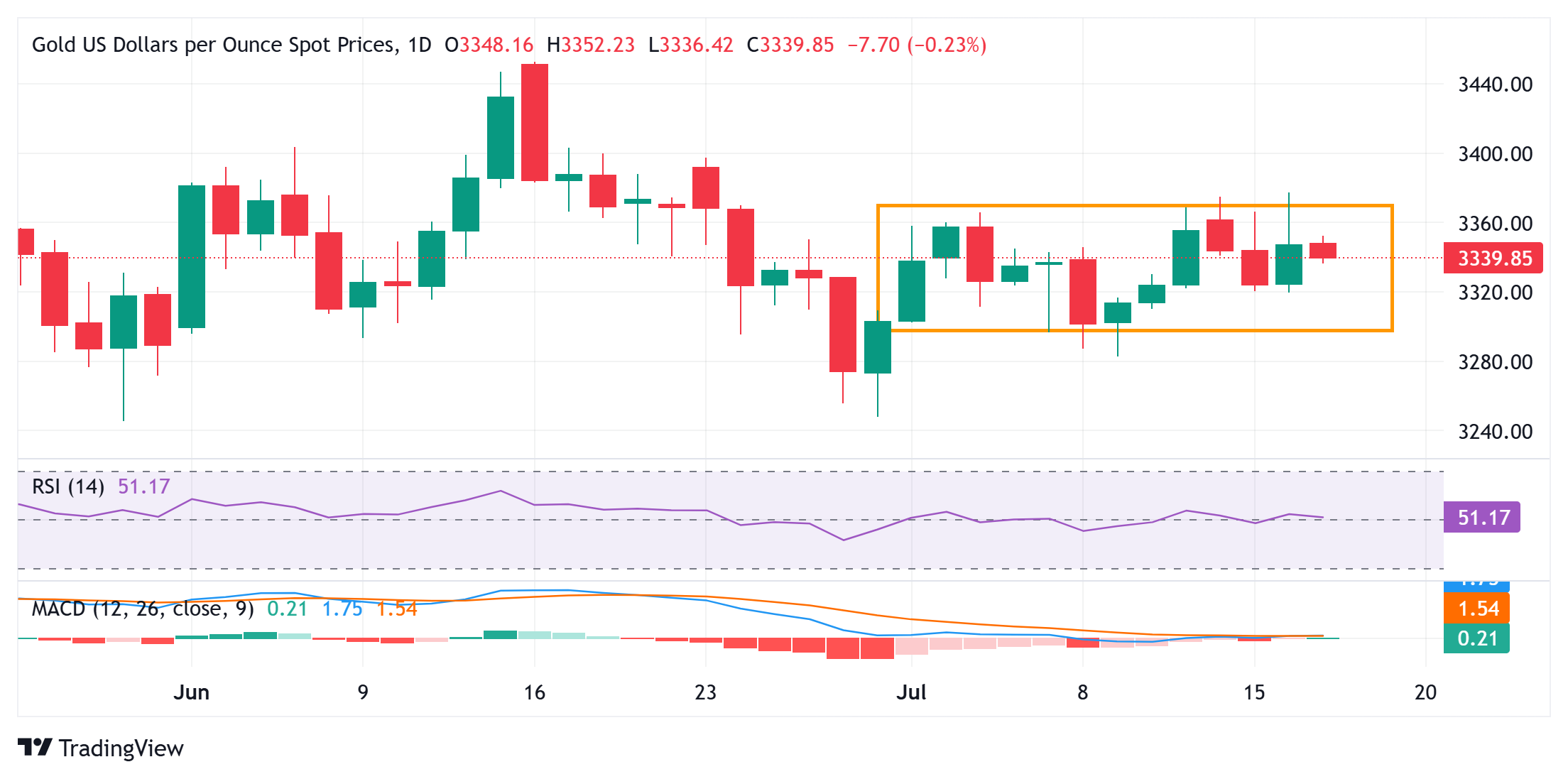Gold price approaches weekly low amid notable USD demand

Gold price (XAU/USD) extends the overnight retracement slide from a multi-week top and continues to lose ground through the first half of the European session on Thursday. US President Donald Trump denied reports that he was unlikely to fire Federal Reserve (Fed) Chair Jerome Powell. Adding to this, bets that the Fed would keep interest rates elevated for an extended period push the US Dollar (USD) back closer to its highest level since June 23, touched on Wednesday, and weigh on the non-yielding yellow metal.
Apart from this, a generally positive tone around the equity markets is seen as another factor denting demand for the Gold price and contributing to the intraday slide. Meanwhile, investors remain on edge amid persistent uncertainties surrounding Trump's erratic trade policies and their impact on the global economy. This might hold back the XAU/USD bears from placing aggressive bets and help limit any further losses. Investors now look to US macro data and speeches from influential FOMC members for a fresh impetus.
Daily Digest Market Movers: Gold price bears retain intraday control as USD retests monthly peak
Gold price weakness below $3,322-3,320 could stall near short-term trading range support
From a technical perspective, the recent range-bound price action since the beginning of this month points to indecision among traders. Furthermore, neutral oscillators on the daily chart warrant some caution before positioning for the next leg of a directional move. Hence, any further slide is more likely to find some support near the $3,322-$3,320 horizontal zone ahead of the $3,300 round figure. Some follow-through selling below the $3,283-3,282 region, or a one-week low touched last Tuesday, would lead to the Gold price accelerating the corrective fall towards the July swing low, around the $3,248-3,247 zone.
On the flip side, the $3,365-3,366 region could act as an immediate hurdle ahead of the $3,377 area, or the overnight high, above which the Gold price could aim to reclaim the $3,400 round figure. Some follow-through buying has the potential to lift the commodity further towards the next relevant hurdle near the $3,434-3,435 area.
Fed FAQs
What does the Federal Reserve do, how does it impact the US Dollar?
Monetary policy in the US is shaped by the Federal Reserve (Fed). The Fed has two mandates: to achieve price stability and foster full employment. Its primary tool to achieve these goals is by adjusting interest rates. When prices are rising too quickly and inflation is above the Fed’s 2% target, it raises interest rates, increasing borrowing costs throughout the economy. This results in a stronger US Dollar (USD) as it makes the US a more attractive place for international investors to park their money. When inflation falls below 2% or the Unemployment Rate is too high, the Fed may lower interest rates to encourage borrowing, which weighs on the Greenback.
How often does the Fed hold monetary policy meetings?
The Federal Reserve (Fed) holds eight policy meetings a year, where the Federal Open Market Committee (FOMC) assesses economic conditions and makes monetary policy decisions. The FOMC is attended by twelve Fed officials – the seven members of the Board of Governors, the president of the Federal Reserve Bank of New York, and four of the remaining eleven regional Reserve Bank presidents, who serve one-year terms on a rotating basis.
What is Quantitative Easing (QE) and how does it impact USD?
In extreme situations, the Federal Reserve may resort to a policy named Quantitative Easing (QE). QE is the process by which the Fed substantially increases the flow of credit in a stuck financial system. It is a non-standard policy measure used during crises or when inflation is extremely low. It was the Fed’s weapon of choice during the Great Financial Crisis in 2008. It involves the Fed printing more Dollars and using them to buy high grade bonds from financial institutions. QE usually weakens the US Dollar.
What is Quantitative Tightening (QT) and how does it impact the US Dollar?
Quantitative tightening (QT) is the reverse process of QE, whereby the Federal Reserve stops buying bonds from financial institutions and does not reinvest the principal from the bonds it holds maturing, to purchase new bonds. It is usually positive for the value of the US Dollar.









_300xx250.jpg)
0 댓글